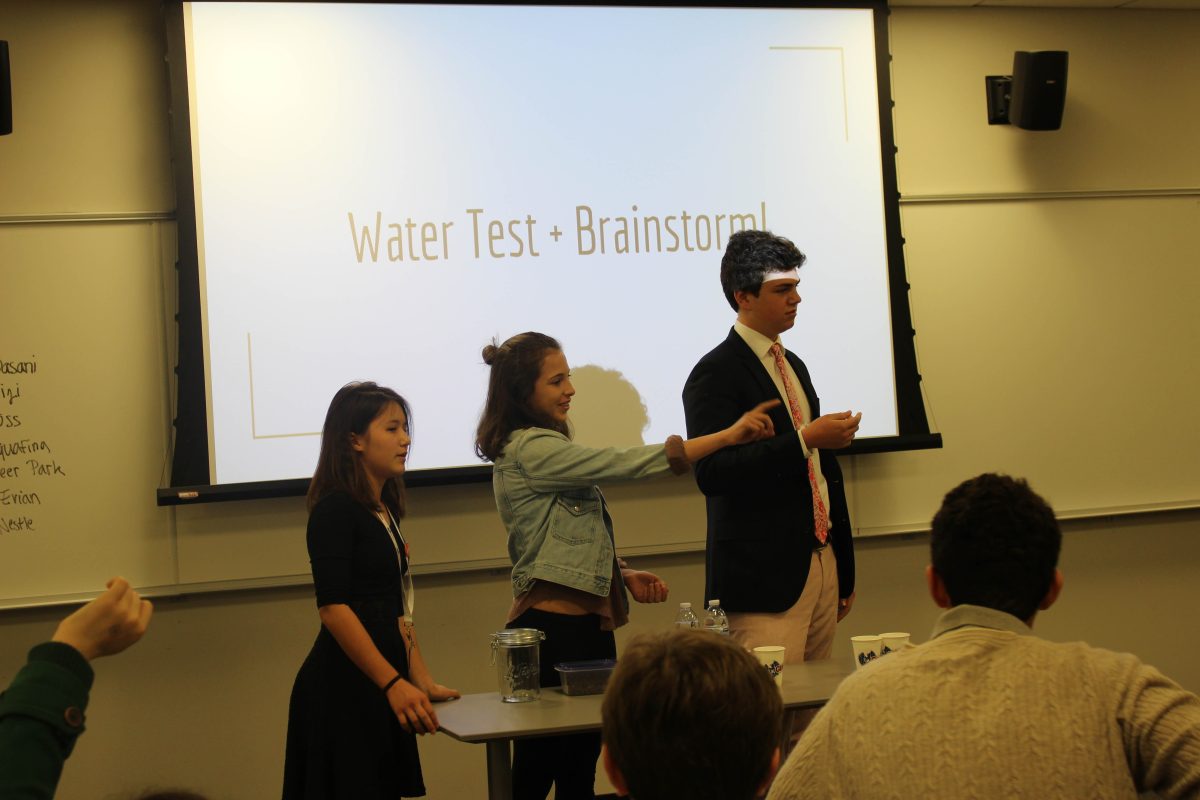This past week at the Global Issue Network Conference in DC, three freshmen from Washington International School, with help from their math teacher, Ms. Riske, presented an important issue: water bottle usage in the USA. Oriane Bui, Annarosa Zampaglione and Alfie Pannell, the students who presented, entertained the audience with their clear slideshow and their engagement with the students, inviting five volunteers to help them ‘test’ the theory.
The “Student Led Breakout” began with some background on how they came up with their topic, which they were very passionate about. Since the beginning of the school year Pannell, Zampaglione, and Bui have been working on “The Water Bottle Project” where they collect the number of plastic bottles saved from the school water fountain which counts as you use it. While making notes of these numbers for months, they decided, with guidance from Ms. Riske, to make a project comparing the usage of tap water to the usage of bottled water in the US and present it at the GIN conference.
To defend their topic that people should stop using plastic bottles and start taking advantage of tap water, the audience learned that half a billion plastic water bottles being thrown away every week and in the US, the plastic bottle consumption increases by eight percent every year.
The presentation was also interactive, Pannell asked the audience for some examples of water bottle brands, while Zampaglione and Bui wrote them down on the whiteboard. After about a dozen brand names on the board, the presenters asked which brand the audience thought is the most popular. Many guesses were thrown out from the students, with Dasani and Aquafina leading.
What really surprised everyone, was that the water from these top brands comes from the same source as tap water and that 48 percent of bottled water is from the tap. This means that the only thing you are paying for in a water bottle is the “fancy and expensive” packaging. While people spend roughly around $115 a month on water bottles, tap water only costs around 50 cents per month making bottled water almost 300 times the price of tap.
On one of the first slides, it showed the materials used to make the plastic bottles, and how chemistry is what makes this plastic bad for the environment. Plastic is made out of oil, water and gas molecules. In the landfill where the bottle ends up, the water molecules evaporate while the gas and oil ones do not. These molecules are harmful and harsh on the environment and air we breathe.
“You think that this alone is bad? Let’s talk about gyres,” Bui said. A gyre is a naturally occurring vortex of wind and currents in the ocean. There are five major gyres in the world, and when plastic (or any trash) lands in the ocean, the gyres “eat’ it and eventually this trash lands on a beach somewhere else in the world. During the transportation of the waste, sea animals mistake it for food, causing them to get sick or die from the toxins.
Currently an estimated 11 tons of plastic waste covers an area of five million square miles in the Pacific Ocean. The number of tons increased 57 percent in the last five years.
Zampaglione then discussed the benefits of tap water. Contrary to what some people think, tap water is actually healthier for you. Tap water contains fluoride, a naturally occurring mineral which helps fight cavities and tooth decay.

The EPA (The Environmental Protection Association) which is the tap water regulator has very strict rules and steps that the water undergoes to become safe. The FDA (Food and Drug Association), the manufacturer of bottled water has less vigilant steps on purifying and regulating their water.
The three presenters researched the water reports of each situation, concluding that the tap water reports are updated everyday and are very detailed, while the bottled water reports are very broad and did not make sense.
Four volunteers were asked to come up and try “water A” and “water B”. When drinking water A, which was actually bottled water, students described it as “weird, chemically and ok”. Water B, tap water was “normal, good and fine”.
The presentation was finished with a question: How can we eliminate this problem of bottle waste? Again, students were asked for their input and answers. Many of the answers mentioned having more water fountains at school and public, purchasing reusable water bottles, banning plastic bottles, and raising prices on bottles. What really stuck with the audience was when Pannell said, “It’s the power of your wallet”.
By Holden Davitian
































































